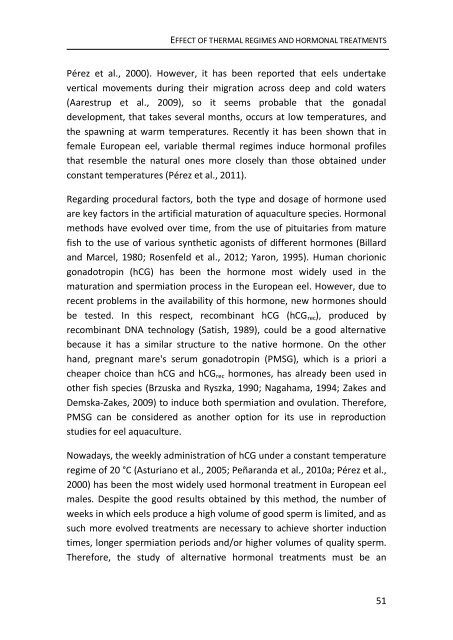chapter 3 - RiuNet
chapter 3 - RiuNet
chapter 3 - RiuNet
You also want an ePaper? Increase the reach of your titles
YUMPU automatically turns print PDFs into web optimized ePapers that Google loves.
EFFECT OF THERMAL REGIMES AND HORMONAL TREATMENTS<br />
Pérez et al., 2000). However, it has been reported that eels undertake<br />
vertical movements during their migration across deep and cold waters<br />
(Aarestrup et al., 2009), so it seems probable that the gonadal<br />
development, that takes several months, occurs at low temperatures, and<br />
the spawning at warm temperatures. Recently it has been shown that in<br />
female European eel, variable thermal regimes induce hormonal profiles<br />
that resemble the natural ones more closely than those obtained under<br />
constant temperatures (Pérez et al., 2011).<br />
Regarding procedural factors, both the type and dosage of hormone used<br />
are key factors in the artificial maturation of aquaculture species. Hormonal<br />
methods have evolved over time, from the use of pituitaries from mature<br />
fish to the use of various synthetic agonists of different hormones (Billard<br />
and Marcel, 1980; Rosenfeld et al., 2012; Yaron, 1995). Human chorionic<br />
gonadotropin (hCG) has been the hormone most widely used in the<br />
maturation and spermiation process in the European eel. However, due to<br />
recent problems in the availability of this hormone, new hormones should<br />
be tested. In this respect, recombinant hCG (hCG rec ), produced by<br />
recombinant DNA technology (Satish, 1989), could be a good alternative<br />
because it has a similar structure to the native hormone. On the other<br />
hand, pregnant mare's serum gonadotropin (PMSG), which is a priori a<br />
cheaper choice than hCG and hCG rec hormones, has already been used in<br />
other fish species (Brzuska and Ryszka, 1990; Nagahama, 1994; Zakes and<br />
Demska-Zakes, 2009) to induce both spermiation and ovulation. Therefore,<br />
PMSG can be considered as another option for its use in reproduction<br />
studies for eel aquaculture.<br />
Nowadays, the weekly administration of hCG under a constant temperature<br />
regime of 20 °C (Asturiano et al., 2005; Peñaranda et al., 2010a; Pérez et al.,<br />
2000) has been the most widely used hormonal treatment in European eel<br />
males. Despite the good results obtained by this method, the number of<br />
weeks in which eels produce a high volume of good sperm is limited, and as<br />
such more evolved treatments are necessary to achieve shorter induction<br />
times, longer spermiation periods and/or higher volumes of quality sperm.<br />
Therefore, the study of alternative hormonal treatments must be an<br />
51
















